warning Lancia Thema 2013 Owner handbook (in English)
[x] Cancel search | Manufacturer: LANCIA, Model Year: 2013, Model line: Thema, Model: Lancia Thema 2013Pages: 336, PDF Size: 3.87 MB
Page 5 of 336

Dear Customer,
Thank you for choosing LANCIA and congratulations on your choice of a LANCIA Thema.
We have written this handbook to help you get to know all your car and use it in the best possible way.
You should read it right through before taking to the road for the first time.
You will find information, tips and important warnings regarding the driving of your car to help you get the most from the
technological features of your LANCIA.
Carefully read the warnings and indications marked with the following symbols:personal safety;
car safety;
environmental protection.
The enclosed Warranty Booklet lists the services that LANCIA offers to its customers:
the Warranty Certificate with terms and conditions for maintaining its validity
the range of additional services available to LANCIA customers.
Enjoy the read. Happy motoring!This Owner Handbook describes all versions of the LANCIA Thema; please consider only the information
relevant to your version, engine and configuration.
Page 9 of 336
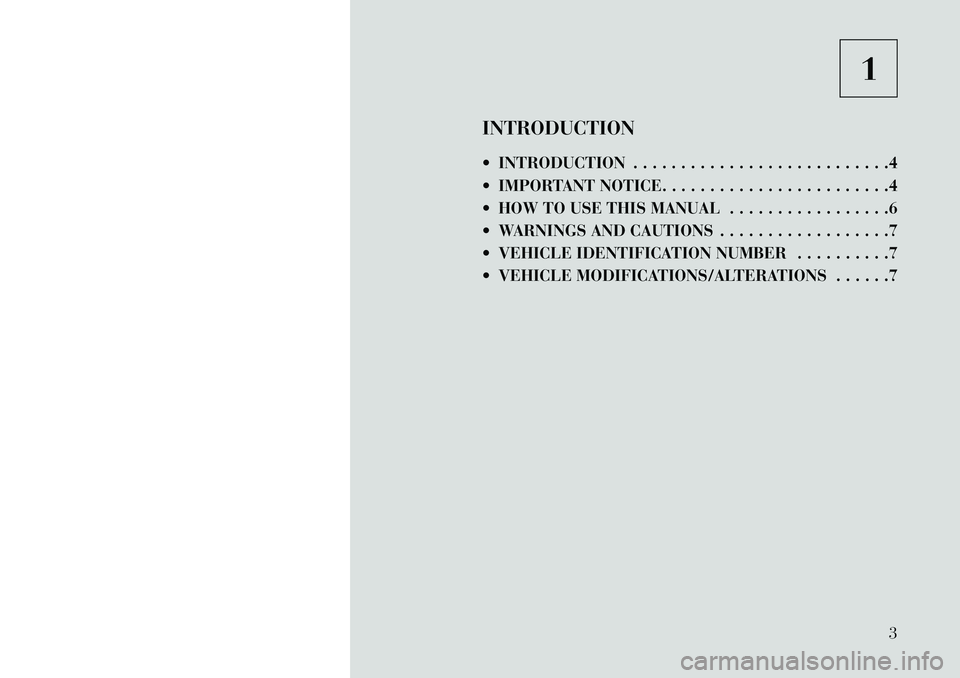
1
INTRODUCTION
INTRODUCTION . . . . . . . . . . . . . . . . . . . . . . . . . . .4
IMPORTANT NOTICE. . . . . . . . . . . . . . . . . . . . . . . .4
HOW TO USE THIS MANUAL . . . . . . . . . . . . . . . . .6
WARNINGS AND CAUTIONS . . . . . . . . . . . . . . . . . .7
VEHICLE IDENTIFICATION NUMBER . . . . . . . . . .7
VEHICLE MODIFICATIONS/ALTERATIONS . . . . . .7
3
Page 13 of 336
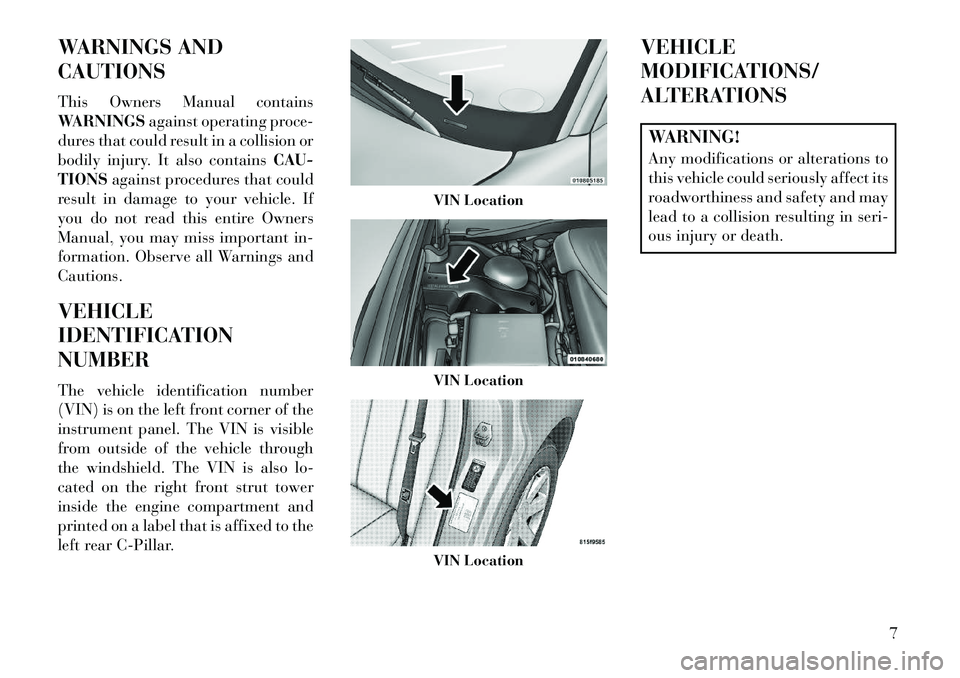
WARNINGS AND
CAUTIONS
This Owners Manual contains
WARNINGSagainst operating proce-
dures that could result in a collision or
bodily injury. It also contains CAU-
TIONS against procedures that could
result in damage to your vehicle. If
you do not read this entire Owners
Manual, you may miss important in-
formation. Observe all Warnings and
Cautions.
VEHICLE
IDENTIFICATION
NUMBER
The vehicle identification number
(VIN) is on the left front corner of the
instrument panel. The VIN is visible
from outside of the vehicle through
the windshield. The VIN is also lo-
cated on the right front strut tower
inside the engine compartment and
printed on a label that is affixed to the
left rear C-Pillar. VEHICLE
MODIFICATIONS/
ALTERATIONS
WARNING!
Any modifications or alterations to
this vehicle could seriously affect its
roadworthiness and safety and may
lead to a collision resulting in seri-
ous injury or death.
VIN LocationVIN LocationVIN Location
7
Page 16 of 336
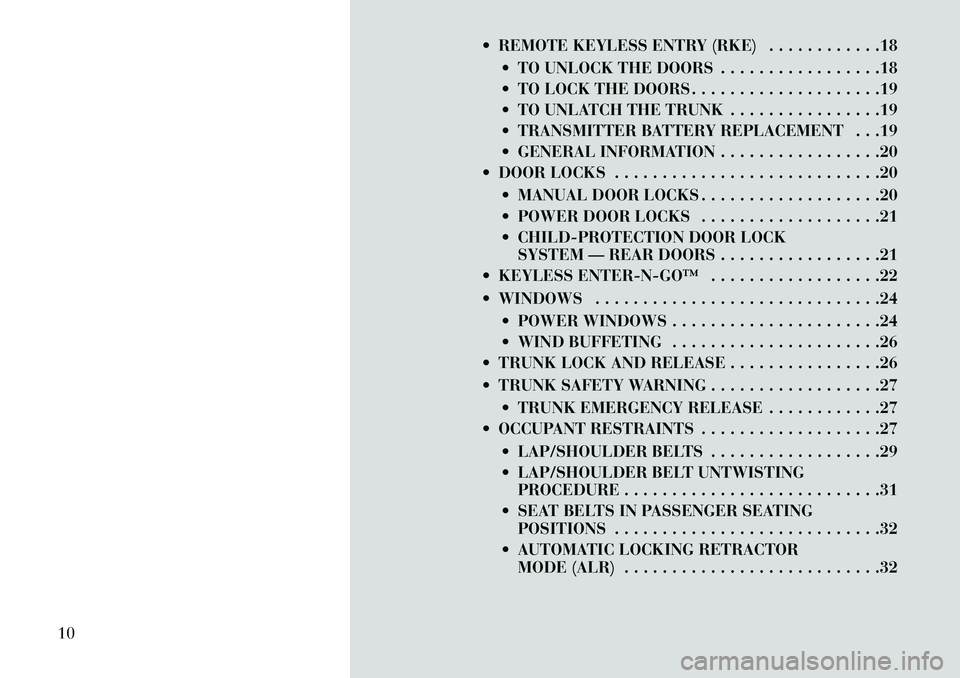
REMOTE KEYLESS ENTRY (RKE) . . . . . . . . . . . .18 TO UNLOCK THE DOORS . . . . . . . . . . . . . . . . .18
TO LOCK THE DOORS . . . . . . . . . . . . . . . . . . . .19
TO UNLATCH THE TRUNK . . . . . . . . . . . . . . . .19
TRANSMITTER BATTERY REPLACEMENT . . .19
GENERAL INFORMATION . . . . . . . . . . . . . . . . .20
DOOR LOCKS . . . . . . . . . . . . . . . . . . . . . . . . . . . .20
MANUAL DOOR LOCKS . . . . . . . . . . . . . . . . . . .20
POWER DOOR LOCKS . . . . . . . . . . . . . . . . . . .21
CHILD-PROTECTION DOOR LOCKSYSTEM — REAR DOORS . . . . . . . . . . . . . . . . .21
KEYLESS ENTERNGO™ . . . . . . . . . . . . . . . . . .22
WINDOWS . . . . . . . . . . . . . . . . . . . . . . . . . . . . . .24
POWER WINDOWS . . . . . . . . . . . . . . . . . . . . . .24
WIND BUFFETING . . . . . . . . . . . . . . . . . . . . . .26
TRUNK LOCK AND RELEASE . . . . . . . . . . . . . . . .26
TRUNK SAFETY WARNING . . . . . . . . . . . . . . . . . .27
TRUNK EMERGENCY RELEASE . . . . . . . . . . . .27
OCCUPANT RESTRAINTS . . . . . . . . . . . . . . . . . . .27
LAP/SHOULDER BELTS . . . . . . . . . . . . . . . . . .29
LAP/SHOULDER BELT UNTWISTINGPROCEDURE . . . . . . . . . . . . . . . . . . . . . . . . . . .31
SEAT BELTS IN PASSENGER SEATING POSITIONS . . . . . . . . . . . . . . . . . . . . . . . . . . . .32
AUTOMATIC LOCKING RETRACTOR MODE (ALR) . . . . . . . . . . . . . . . . . . . . . . . . . . .32
10
Page 19 of 336

IGNITION OR ACCESSORY
ON MESSAGE
Opening the driver's door when the
ignition is in ACC or ON (engine not
running), a chime will sound to re-
mind you to cycle the ignition to OFF.
In addition to the chime, the ignition
or accessory on message will display
in the cluster.
NOTE:
With the Uconnect Touch™
system, the power window switches,
radio, power sunroof (for versions/
markets, where provided), and
power outlets will remain active for
up to 10 minutes after the ignition is
cycled to the OFF position. Opening
either front door will cancel this fea-
ture. The time for this feature is pro-
grammable. Refer to “Uconnect
Touch™ Settings” in “Understand-
ing Your Instrument Panel” for fur-
ther information.
WARNING!
When leaving the vehicle, always remove the Key Fob from the
vehicle and lock your vehicle.
Never leave children alone in a vehicle, or with access to an un-
locked vehicle.
Allowing children to be in a ve- hicle unattended is dangerous
for a number of reasons. A child
or others could be seriously or
fatally injured. Children should
be warned not to touch the park-
ing brake, brake pedal or the shift
lever.
Do not leave the Key Fob in or near the vehicle, or in a location
accessible to children, and do not
leave Keyless EnterNGo™ in
the ACC or ON/RUN mode. A
child could operate power win-
dows, other controls, or move the
vehicle.
Do not leave children or animals
inside parked vehicles in hot
weather. Interior heat build-up
may cause serious injury or death.
CAUTION!
An unlocked car is an invitation to
thieves. Always remove the Key
Fob from vehicle, cycle the ignition
OFF and lock all doors when leav-
ing the vehicle unattended.
SENTRY KEY®
The Sentry Key® Immobilizer System
prevents unauthorized vehicle oper-
ation by disabling the engine. The
system does not need to be armed or
activated. Operation is automatic,
regardless of whether the vehicle is
locked or unlocked.
The system uses a Key Fob with
Remote Keyless Entry (RKE) trans-
mitter, a Keyless Ignition Node (KIN)
and a RF receiver to prevent unau-
thorized vehicle operation. Therefore,
only Key Fobs that are programmed
to the vehicle can be used to start and
operate the vehicle.After placing the ignition in the ON/
RUN position, the Vehicle Security
13
Page 26 of 336
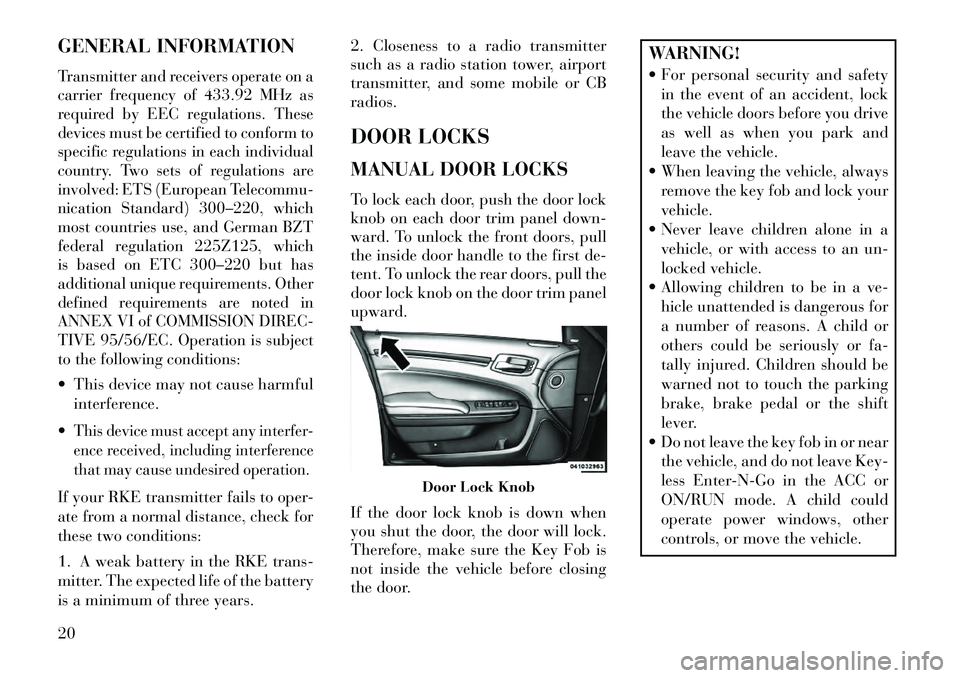
GENERAL INFORMATIONTransmitter and receivers operate on a
carrier frequency of 433.92 MHz as
required by EEC regulations. These
devices must be certified to conform to
specific regulations in each individual
country. Two sets of regulations are
involved: ETS (European Telecommu-
nication Standard) 300–220, which
most countries use, and German BZT
federal regulation 225Z125, which
is based on ETC 300–220 but has
additional unique requirements. Other
defined requirements are noted in
ANNEX VI of COMMISSION DIREC-
TIVE 95/56/EC. Operation is subject
to the following conditions: This device may not cause harmfulinterference.
This device must accept any interfer-
ence received, including interference
that may cause undesired operation.If your RKE transmitter fails to oper-
ate from a normal distance, check for
these two conditions:
1. A weak battery in the RKE trans-
mitter. The expected life of the battery
is a minimum of three years. 2. Closeness to a radio transmitter
such as a radio station tower, airport
transmitter, and some mobile or CB
radios.
DOOR LOCKS
MANUAL DOOR LOCKS
To lock each door, push the door lock
knob on each door trim panel down-
ward. To unlock the front doors, pull
the inside door handle to the first de-
tent. To unlock the rear doors, pull the
door lock knob on the door trim panel
upward.
If the door lock knob is down when
you shut the door, the door will lock.
Therefore, make sure the Key Fob is
not inside the vehicle before closing
the door.
WARNING!
For personal security and safety
in the event of an accident, lock
the vehicle doors before you drive
as well as when you park and
leave the vehicle.
When leaving the vehicle, always
remove the key fob and lock your
vehicle.
Never leave children alone in a vehicle, or with access to an un-
locked vehicle.
Allowing children to be in a ve- hicle unattended is dangerous for
a number of reasons. A child or
others could be seriously or fa-
tally injured. Children should be
warned not to touch the parking
brake, brake pedal or the shift
lever.
Do not leave the key fob in or near the vehicle, and do not leave Key-
less Enter-N-Go in the ACC or
ON/RUN mode. A child could
operate power windows, other
controls, or move the vehicle.
Door Lock Knob
20
Page 28 of 336

To Engage Or Disengage The
Child-Protection Door Lock
System
1. Open the rear door.
2. Insert the tip of the emergency key
into the lock and rotate to the LOCK
or UNLOCK position.
3. Repeat steps 1 and 2 for the oppo-
site rear door.WARNING!Avoid trapping anyone in a vehicle in
a collision. Remember that the rear
doors can only be opened from the
outside when the Child-Protection
locks are engaged (locked).
NOTE: For emergency exit from
the rear seats when the Child-
Protection Door Lock System is
engaged, manually raise the door
lock knob to the unlocked posi-
tion, roll down the window, and
open the door using the outside
door handle.KEYLESS ENTERNGO™The Passive Entry system is an en-
hancement to the vehicle’s Remote
Keyless Entry (RKE) system and a
feature of Keyless EnterNGo™.
This feature allows you to lock and
unlock the vehicle’s door(s) without
having to press the RKE transmitter
lock or unlock buttons.
NOTE:
Passive Entry may be pro-grammed ON/OFF; refer to
“Uconnect Touch™ Settings” in
“Understanding Your Instru-
ment Panel” for further infor-
mation.
If wearing gloves on your hands,
or if it has been raining on the
Passive Entry door handle, the unlock sensitivity can be affected,
resulting in a slower response
time.
If the vehicle is unlocked by
the RKE transmitter or Passive
Entry and no door goes ajar
within 60 seconds, the vehicle
will re-lock and will arm the
theft alarm.
To Unlock From The Driver's Side:
With a valid Passive Entry RKE
transmitter within 1.5 m of the driv-
er's door handle, grab the front driver
door handle to unlock the driver's
door automatically. The interior door
panel lock knob will raise when the
door is unlocked.
Child-Protection Door Lock Function
Grabbing The Driver's Door Handle
22
Page 31 of 336
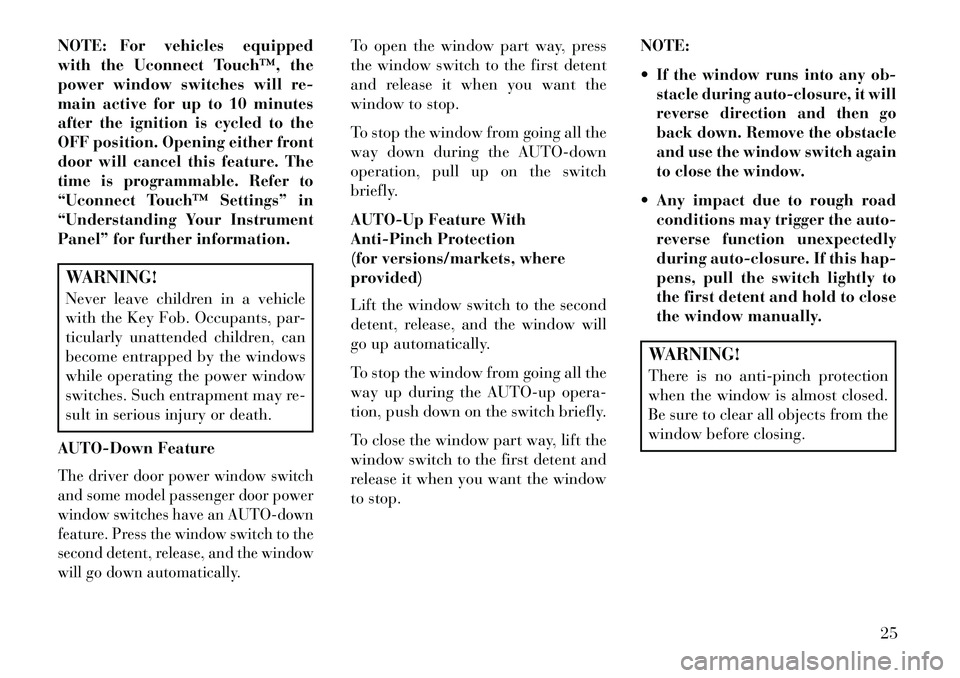
NOTE: For vehicles equipped
with the Uconnect Touch™, the
power window switches will re-
main active for up to 10 minutes
after the ignition is cycled to the
OFF position. Opening either front
door will cancel this feature. The
time is programmable. Refer to
“Uconnect Touch™ Settings” in
“Understanding Your Instrument
Panel” for further information.WARNING!
Never leave children in a vehicle
with the Key Fob. Occupants, par-
ticularly unattended children, can
become entrapped by the windows
while operating the power window
switches. Such entrapment may re-
sult in serious injury or death.
AUTO-Down FeatureThe driver door power window switch
and some model passenger door power
window switches have an AUTO-down
feature. Press the window switch to the
second detent, release, and the window
will go down automatically.
To open the window part way, press
the window switch to the first detent
and release it when you want the
window to stop.
To stop the window from going all the
way down during the AUTO-down
operation, pull up on the switch
briefly.
AUTO-Up Feature With
Anti-Pinch Protection
(for versions/markets, where
provided)
Lift the window switch to the second
detent, release, and the window will
go up automatically.
To stop the window from going all the
way up during the AUTO-up opera-
tion, push down on the switch briefly.
To close the window part way, lift the
window switch to the first detent and
release it when you want the window
to stop. NOTE:
If the window runs into any ob-
stacle during auto-closure, it will
reverse direction and then go
back down. Remove the obstacle
and use the window switch again
to close the window. Any impact due to rough road
conditions may trigger the auto-
reverse function unexpectedly
during auto-closure. If this hap-
pens, pull the switch lightly to
the first detent and hold to close
the window manually.WARNING!
There is no anti-pinch protection
when the window is almost closed.
Be sure to clear all objects from the
window before closing.
25
Page 33 of 336
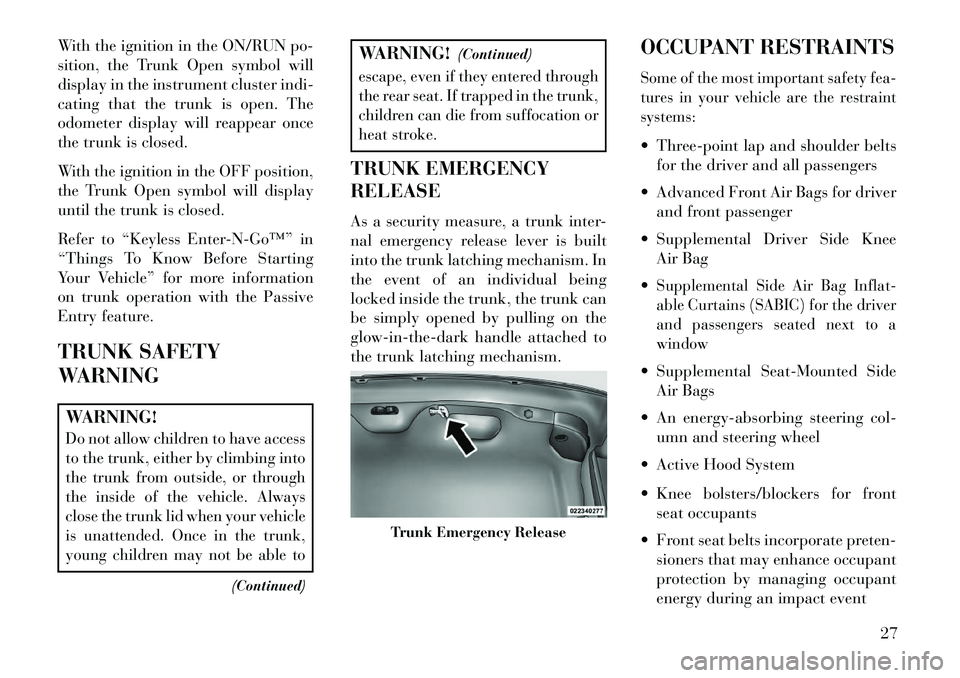
With the ignition in the ON/RUN po-
sition, the Trunk Open symbol will
display in the instrument cluster indi-
cating that the trunk is open. The
odometer display will reappear once
the trunk is closed.
With the ignition in the OFF position,
the Trunk Open symbol will display
until the trunk is closed.
Refer to “Keyless EnterNGo™” in
“Things To Know Before Starting
Your Vehicle” for more information
on trunk operation with the Passive
Entry feature.
TRUNK SAFETY
WARNINGWARNING!Do not allow children to have access
to the trunk, either by climbing into
the trunk from outside, or through
the inside of the vehicle. Always
close the trunk lid when your vehicle
is unattended. Once in the trunk,
young children may not be able to
(Continued)
WARNING!(Continued)escape, even if they entered through
the rear seat. If trapped in the trunk,
children can die from suffocation or
heat stroke.TRUNK EMERGENCY
RELEASE
As a security measure, a trunk inter-
nal emergency release lever is built
into the trunk latching mechanism. In
the event of an individual being
locked inside the trunk, the trunk can
be simply opened by pulling on the
glow-in-the-dark handle attached to
the trunk latching mechanism. OCCUPANT RESTRAINTS
Some of the most important safety fea-
tures in your vehicle are the restraint
systems: Three-point lap and shoulder belts
for the driver and all passengers
Advanced Front Air Bags for driver and front passenger
Supplemental Driver Side Knee Air Bag
Supplemental Side Air Bag Inflat-
able Curtains (SABIC) for the driver
and passengers seated next to a
window Supplemental Seat-Mounted Side Air Bags
An energy-absorbing steering col- umn and steering wheel
Active Hood System
Knee bolsters/blockers for front seat occupants
Front seat belts incorporate preten- sioners that may enhance occupant
protection by managing occupant
energy during an impact event
Trunk Emergency Release
27
Page 34 of 336

All seat belt systems (except the
driver’s and front passenger's) in-
clude Automatic Locking Retractors
(ALRs), which lock the seat belt
webbing into position by extending
the belt all the way out and then
adjusting the belt to the desired
length to restrain a child seat or
secure a large item in a seatPlease pay close attention to the infor-
mation in this section. It tells you how
to use your restraint system properly,
to keep you and your passengers as
safe as possible.
If you will be carrying children too
small for adult-sized seat belts, the
seat belts or the ISOFIX feature also
can be used to hold infant and child
restraint systems. For more informa-
tion, refer to ISOFIX — Child Seat
Anchorage System.
NOTE: The Advanced Front Air
Bags have a multistage inflator
design. This allows the air bag to
have different rates of inflation
based on several factors, including
the severity and type of collision.Here are some simple steps you can
take to minimize the risk of harm
from a deploying air bag:
1.
Children 12 years old and un-
der should always ride buckled up
in a rear seat.
WARNING!
Infants in rear facing child re-
straints should never ride in the
front seat of a vehicle with a pas-
senger Advanced Front Air Bag.
An air bag deployment can cause
severe injury or death to infants in
that position.
Children that are not big enough to
wear the vehicle seat belt properly
(see section on Child Restraints)
should be secured in the rear seat in
child restraints or belt-positioning
booster seats. Older children who do
not use child restraints or belt-
positioning booster seats should ride
properly buckled up in the rear seat.
Never allow children to slide the
shoulder belt behind them or under
their arm.
You should read the instructions pro-
vided with your child restraint to make
sure that you are using it properly.2. All occupants should always
wear their lap and shoulder belts
properly.
3. The driver and front passenger
seats should be moved back as far
as practical to allow the Advanced
Front Air Bags room to inflate.
4. Do not lean against the door or
window. If your vehicle has side
air bags, and deployment occurs,
the side air bags will inflate force-
fully into the space between you
and the door.
5. If the air bag system in this
vehicle needs to be modified to
accommodate a disabled person,
contact the Customer Center.WARNING!
Infants in rear facing child re-
straints should never ride in the
front seat of a vehicle with a pas-
senger Advanced Front Air Bag.
(Continued)
28